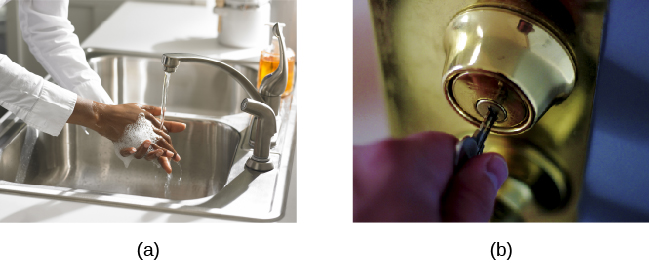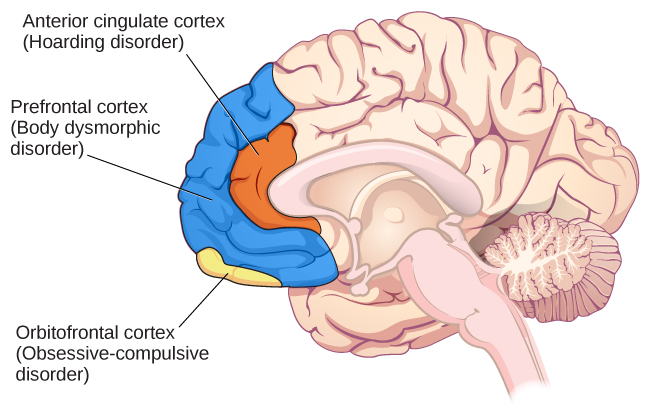Chapter 14: Biopsychology of Psychological Disorders
Obsessive-compulsive and related disorders are a group of overlapping disorders that generally involve intrusive, unpleasant thoughts or repetitive behaviors. Many of us experience unwanted thoughts from time to time (e.g., craving double cheeseburgers when dieting), and many of us engage in repetitive behaviors on occasion (e.g., pacing when nervous). However, obsessive-compulsive and related disorders elevate the unwanted thoughts and repetitive behaviors to a status so intense that these cognitions and activities disrupt daily life. Included in this category are obsessive-compulsive disorder (OCD), body dysmorphic disorder, and hoarding disorder.[1]
OCD is marked by the presence of obsessions, compulsions, or both, that are time-consuming (e.g., more than 1 hour per day), and not attributable to a substance like a drug, another medical condition, or another mental disorder (APA, 2013). Obsessions are more than just unwanted thoughts that seem to randomly jump into our head from time to time, such as recalling an insensitive remark a coworker made recently, and they are more significant than the minor day-to-day worries we might have. Rather, obsessions are characterized as persistent, unintentional, and unwanted thoughts and urges that are highly intrusive, unpleasant, and distressing (APA, 2013). Common obsessions include concerns about germs and contamination, doubts (“Did I turn the water off?”), order and symmetry (“I need all the spoons in the tray to be arranged a certain way”), and urges that are aggressive or lustful. Usually, the person knows that such thoughts and urges are irrational and thus tries to suppress or ignore them, but has an extremely difficult time doing so. These obsessive symptoms sometimes overlap, such that someone might have both contamination and aggressive obsessions (Abramowitz & Siqueland, 2013).

Compulsions are repetitive and ritualistic acts that are typically carried out primarily as a means to minimize the distress that obsessions trigger or to reduce the likelihood of a feared event (APA, 2013). Compulsions often include such behaviors as repeated and extensive hand washing, cleaning, checking (e.g., that a door is locked), and ordering (e.g., lining up all the pencils in a particular way), and they also include such mental acts as counting or reciting something to oneself (Figure 14.3). Compulsions characteristic of OCD are not performed out of pleasure, nor are they connected in a realistic way to the source of the distress or feared event. Ultimately, a difficult cycle of obsessive thoughts, anxiety, compulsions, and temporary relief tends to deeply affect individuals with OCD (Figure 14.4). Approximately 2.3% of the U.S. population will experience OCD in their lifetime (Ruscio et al., 2010) and, if left untreated, OCD tends to be a chronic condition creating lifelong interpersonal and psychological problems (Norberg et al., 2008).[2]

Body Dysmorphic Disorder
A disorder that shares similar features to OCD is body dysmorphic disorder, wherein an individual is preoccupied with a perceived flaw in physical appearance that is either nonexistent or barely noticeable to other people (APA, 2013). These perceived physical defects cause people to think they are unattractive, ugly, hideous, or deformed. These preoccupations can focus on any bodily area, but they typically involve the skin, face, or hair. The preoccupation with imagined physical flaws drives the person to engage in repetitive and ritualistic behavioral and mental acts, such as constantly looking in the mirror, trying to hide the offending body part, comparisons with others, and, in some extreme cases, cosmetic surgery (Phillips, 2005). An estimated 2.4% of the adults in the United States meet the criteria for body dysmorphic disorder, with slightly higher rates in women than in men (APA, 2013).[3]
Hoarding Disorder
Although hoarding was traditionally considered a symptom of OCD, considerable evidence suggests that hoarding represents an entirely different disorder (Mataix-Cols et al., 2010). People with hoarding disorder cannot bear to part with personal possessions, regardless of how valueless or useless these possessions are. As a result, these individuals accumulate excessive amounts of usually worthless items that clutter their living areas. Often, the quantity of cluttered items is so excessive that the person is unable to use their kitchen, or sleep in their bed. People who suffer from this disorder have great difficulty parting with items because they believe the items might be of some later use, or because they form a sentimental attachment to the items (APA, 2013). Importantly, a diagnosis of hoarding disorder is made only if the hoarding is not caused by another medical condition and is not a symptom of another disorder (e.g., schizophrenia) (APA, 2013).[4]
Neural and genetic mechanisms underlying obsessive-compulsive and related disorders
The results of family and twin studies suggest that OCD has a moderate genetic component. The disorder is five times more frequent in the first-degree relatives of people with OCD than in people without the disorder (Nestadt et al., 2000). Additionally, the concordance rate of OCD is 57% for identical twins and 22% for fraternal twins (Bolton et al., 2007). Studies have implicated about two dozen potential genes that may be involved in OCD; these genes regulate the function of three neurotransmitters: serotonin, dopamine, and glutamate (Pauls, 2010). Many of these studies included small sample sizes and have yet to be replicated, so additional research is needed.
A brain region believed to play a critical role in OCD is the orbitofrontal cortex (Kopell & Greenberg, 2008) (Figure 7). In people with OCD, the orbitofrontal cortex becomes especially hyperactive when they are provoked with tasks in which, for example, they are asked to look at a photo of a toilet or of pictures hanging crookedly on a wall (Simon et al., 2010). The orbitofrontal cortex is part of a group of brain regions that, collectively, is called the OCD circuit and influences the perceived emotional value of stimuli and the selection of both behavioral and cognitive responses (Graybiel & Rauch, 2000). As with the orbitofrontal cortex, other regions of the OCD circuit (e.g., dorsolateral prefrontal cortex, precuneus, and left superior temporal gyrus) show heightened activity during symptom provocation (Rotge et al., 2008), which suggests that abnormalities in these regions may contribute to the symptoms of OCD (Saxena et al., 2001). Consistent with this network explanation, people with OCD show substantially higher connectivity of the orbitofrontal cortex with other regions of the OCD circuit (Beucke et al., 2013).

Neuroimaging studies have also highlighted the role of the prefrontal cortex in OCD and body dysmorphic disorder. Individuals with body dysmorphic disorder often show abnormal perception of body areas. An fMRI study showed that when people with body dysmorphia viewed faces, they had abnormal prefrontal cortex activity, which may be associated with the perceptual distortions seen in body dysmorphic disorder (Feusner et al., 2007).
These neuroimaging findings highlight the importance of brain dysfunction in OCD and body dysmorphic disorder. However, neuroimaging approaches are limited by their inability to explain differences in obsessions and compulsions, and correlations between brain abnormalities and OCD symptoms is not evidence of causality (Abramowitz & Siqueland, 2013).
Several approaches are commonly used to treat OCD. One effective treatment is a form of Cognitive Behavioral Therapy called exposure and response prevention. In therapy sessions, individuals with OCD are gradually exposed to situations or objects designed to mildly provoke their obsessions in a safe environment and are instructed to avoid their compulsive responses. Eventually, the high anxiety situations become less anxiety provoking and more manageable. Exposure and response is also very effective with panic disorder (which is an anxiety disorder). Cognitive Behavioral Therapy is often used in conjunction with pharmacological treatments for OCD. Selective serotonin reuptake inhibitors (SSRIs) are used to treat OCD, but often at higher doses than are used to treat depression. Finally, OCD can be treated effectively with brain stimulation, including both non-invasive techniques like transcranial magnetic stimulation that uses magnetic pulses to stimulate the prefrontal cortex (Trevizol et al., 2016), and invasive techniques like deep brain stimulation that requires surgically implanting a device deep in the brain that can modulate activity in the OCD brain circuit (Alonso et al., 2015).[5]
- This section contains material adapted from: Spielman, R. M., Jenkins, W. J., & Lovett, M. D. (2020). 15.5 Obsessive-Compulsive and Related Disorders. In Psychology 2e. OpenStax. Access for free at https://openstax.org/books/psychology-2e/pages/15-5-obsessive-compulsive-and-related-disorders License: CC BY 4.0 DEED. ↵
- This section contains material adapted from: Spielman, R. M., Jenkins, W. J., & Lovett, M. D. (2020). 15.5 Obsessive-Compulsive and Related Disorders. In Psychology 2e. OpenStax. Access for free at https://openstax.org/books/psychology-2e/pages/15-5-obsessive-compulsive-and-related-disorders License: CC BY 4.0 DEED. ↵
- This section contains material adapted from: Spielman, R. M., Jenkins, W. J., & Lovett, M. D. (2020). 15.5 Obsessive-Compulsive and Related Disorders. In Psychology 2e. OpenStax. Access for free at https://openstax.org/books/psychology-2e/pages/15-5-obsessive-compulsive-and-related-disorders License: CC BY 4.0 DEED. ↵
- This section contains material adapted from: Spielman, R. M., Jenkins, W. J., & Lovett, M. D. (2020). 15.5 Obsessive-Compulsive and Related Disorders. In Psychology 2e. OpenStax. Access for free at https://openstax.org/books/psychology-2e/pages/15-5-obsessive-compulsive-and-related-disorders License: CC BY 4.0 DEED. ↵
- This section contains material adapted from: Spielman, R. M., Jenkins, W. J., & Lovett, M. D. (2020). 15.5 Obsessive-Compulsive and Related Disorders. In Psychology 2e. OpenStax. Access for free at https://openstax.org/books/psychology-2e/pages/15-5-obsessive-compulsive-and-related-disorders License: CC BY 4.0 DEED. ↵
A group of disorders that center on a cycle of intrusive thoughts, feelings of anxiety, repetitive behaviors, and short-term reliefs.
A class of psychological disorders; characterized by mania as the defining feature
A type of obsessive-compulsive disorder. Characterized by persistent difficulty in parting with possessions due to a perceived need to save the items
